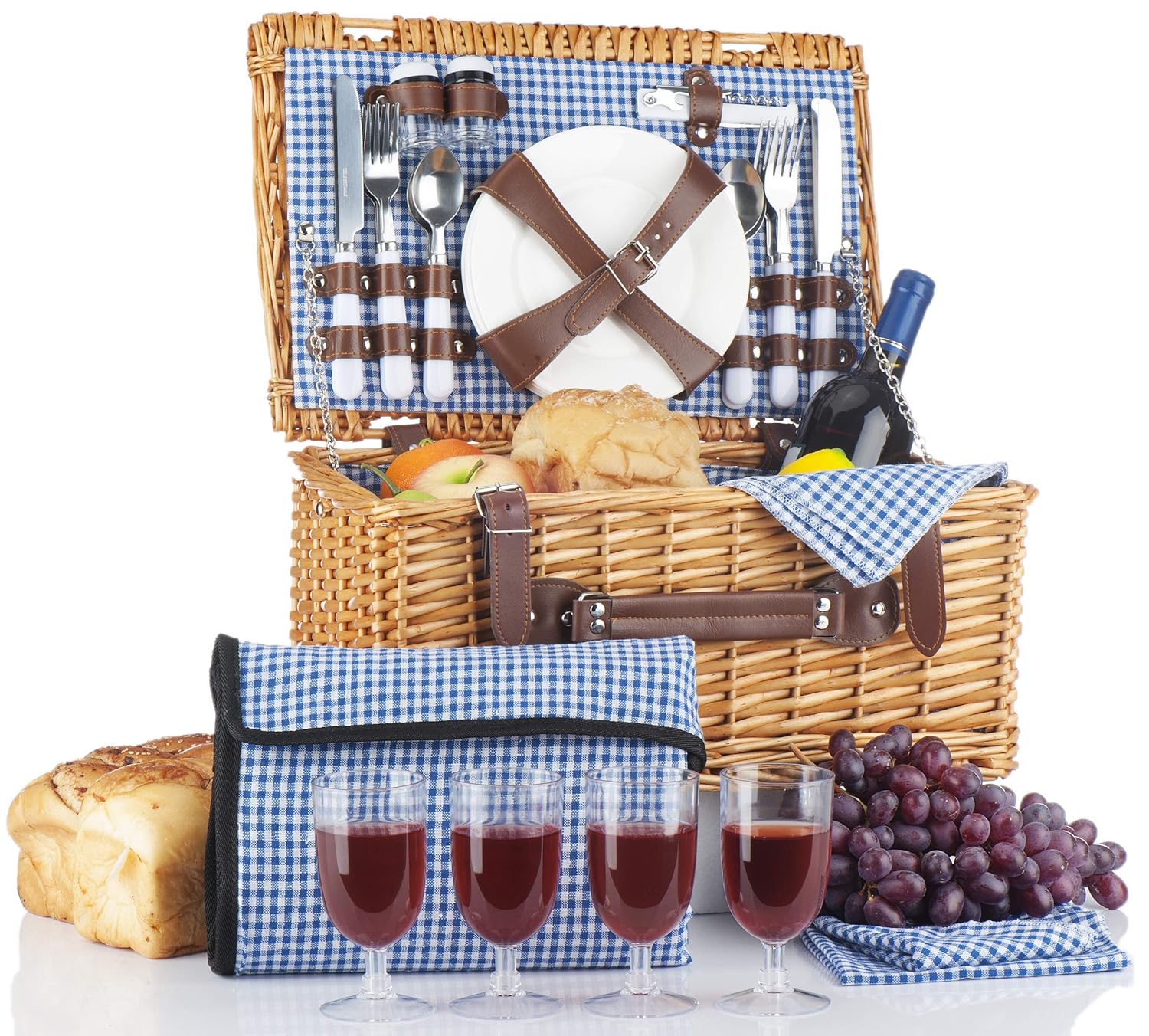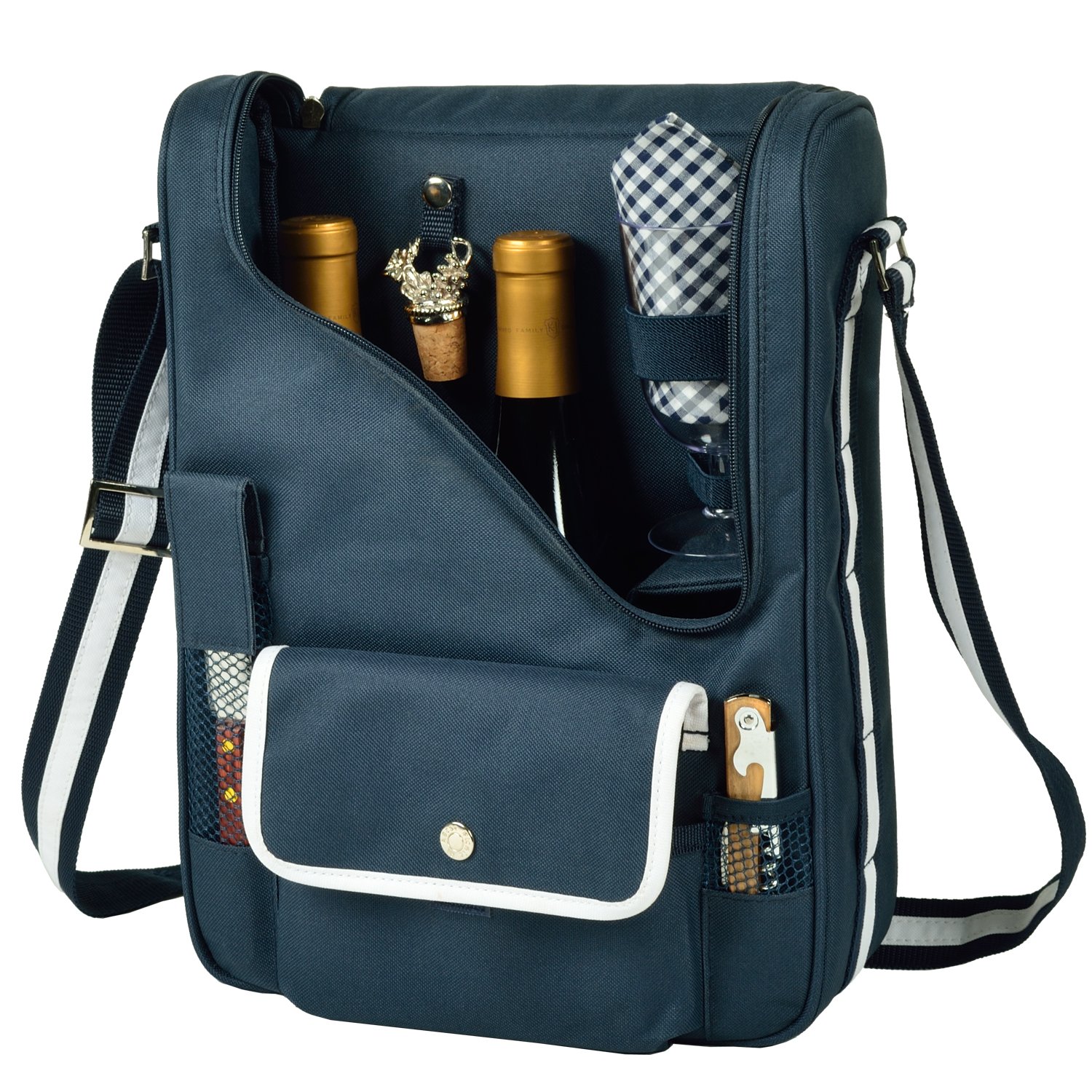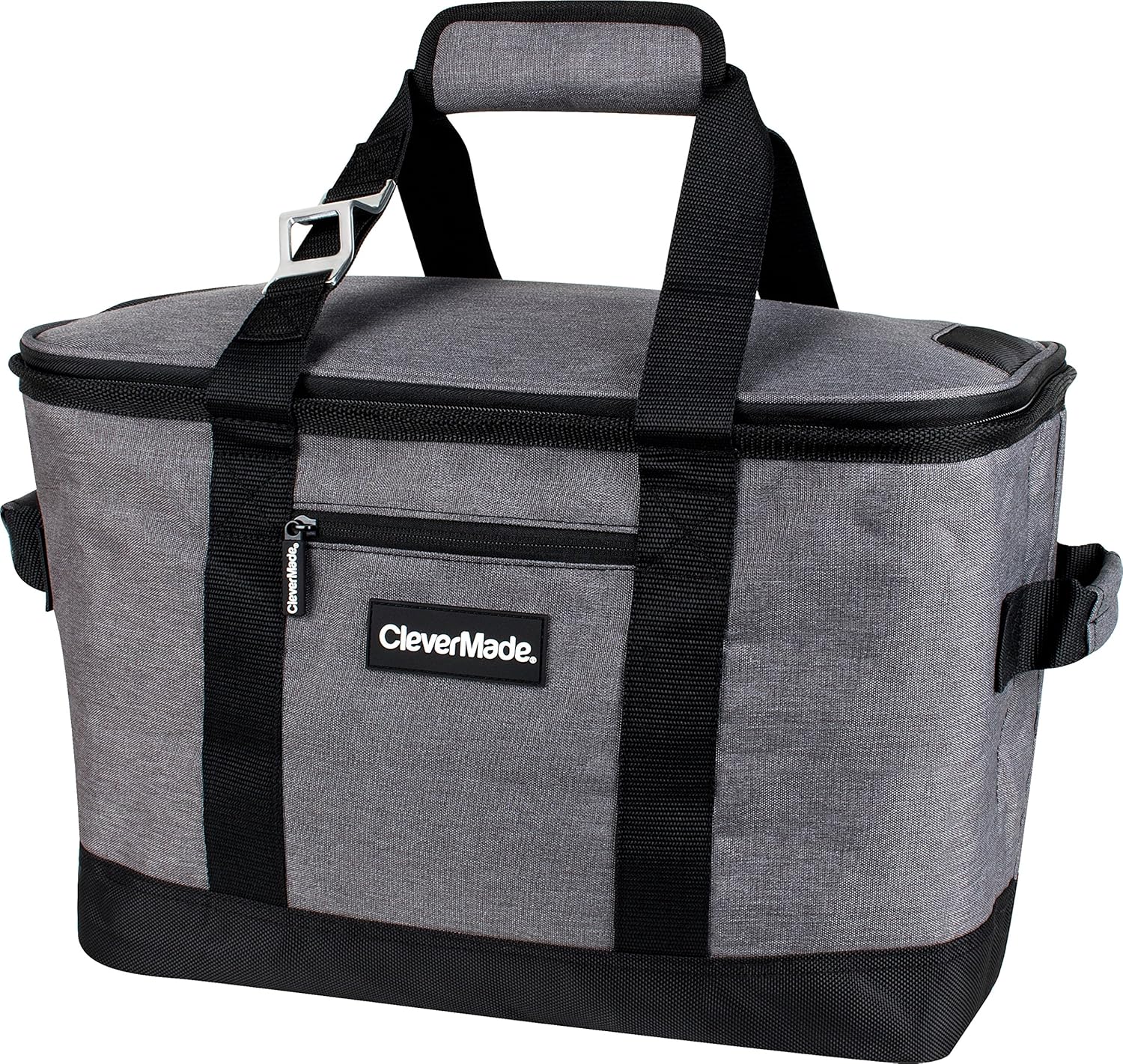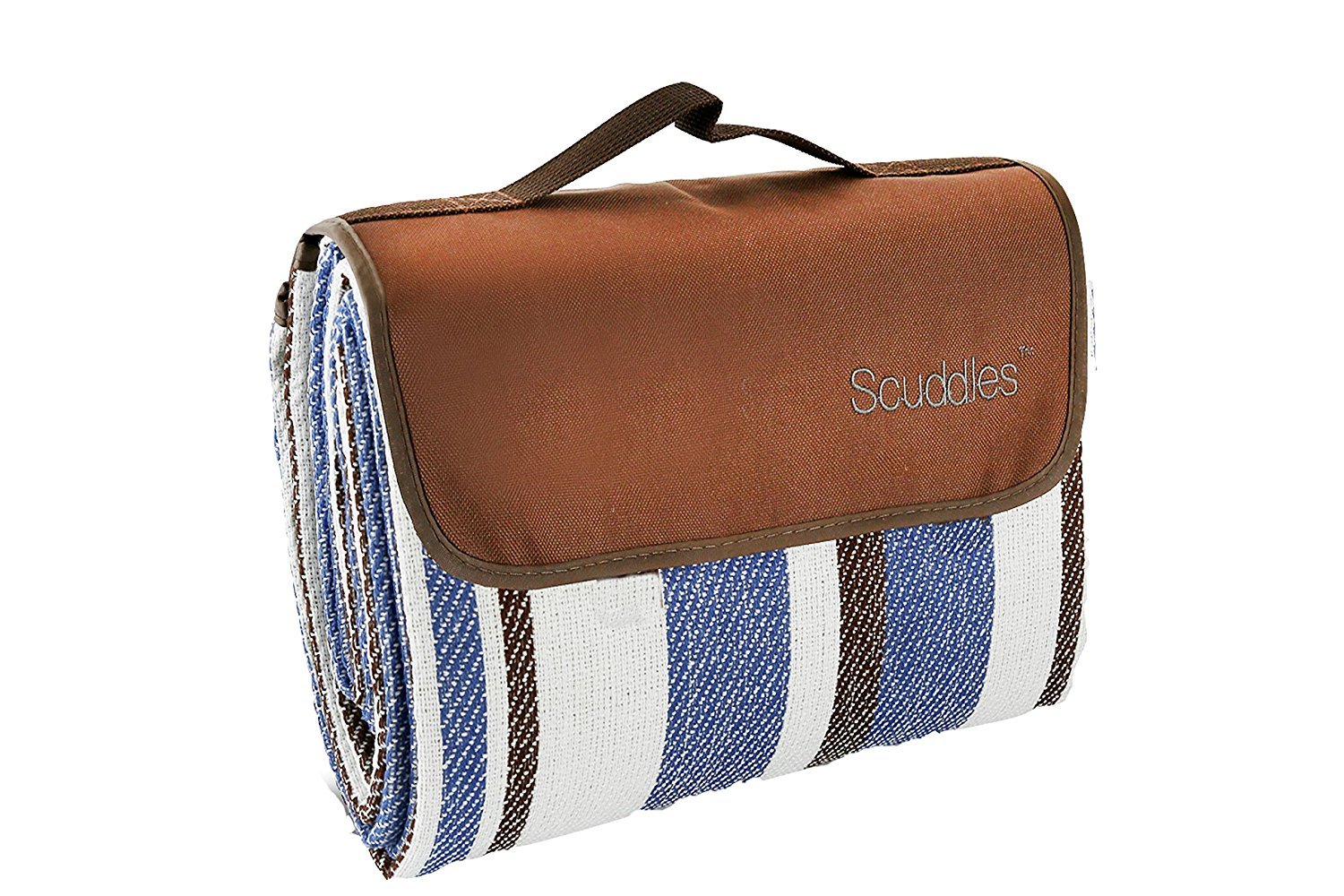
The picnic is one of the annual joys of warm-weather (and sometimes cool-weather) eating, and our guide to packing the best picnic ever will ensure you have a perfect time, wherever you are. On West Coast beaches, where the Pacific crashes into rocks along the horizon; in Midwest forests, and among the dunes of Lake Michigan; and in manicured urban parks in the Northeast, we love nothing better than to lift the lid of a cooler, flip open an old-fashioned hamper, and pop the lids of Tupperware to lay out a feast.
California Picnic Wicker Picnic Basket for 4, $45.95 on Amazon
Old-fashioned charm and practicality.
Planning a picnic is more than just dragging outdoors the food you’d already be cooking. Throwing a great picnic is the result of a few factors: the setting, the weather (obviously), and the ease of serving and assembly (grilling marinated chicken skewers or portobello mushroom caps on coals is one thing; assembling and cooking panini on site, in a cast iron skillet precariously perched on cinderblocks over a fire, is another).
Still, we’re living in an era of peak picnic. Whereas in the 1970s and ‘80s opening a pack of Ballpark hot dogs and untwisting some supermarket buns would’ve passed for a fine outdoor meal, we’ve gotten more sophisticated, both in our creativity with food and our eye for serving pieces (big thanks to Pinterest for upping our collective game when it comes to the latter).
Let’s start by looking back, though—at the rich past of picnicking.

History On a Blanket
Picnics were born in the sumptuous outdoor feasts that were traditions of the wealthy. Medieval hunting feasts, Renaissance country banquets, and Victorian garden parties: They’re all precursors of even humble cookouts in the 21st century. This wasn’t merely a European tradition. Similar outdoor feasts took place in Persia, China, and other non-Western geo locations.
The first picnics, in England anyway, were medieval hunting feasts: pastries, hams, baked meats, and more. They stayed much the same, though adjusted according to the wealth of a household, until the Victorian era, arguably the most refined era in the history of picnics. Nineteenth-century painters (Monet, Renoir, Cezanne) were brilliant chroniclers of picnics and outdoor entertainments.

Chowhound’s French Lentil Terrine with Savory Carrot Custard
Where Did the Word “Picnic” Come From?
Our rather curious English word derives from the French pique nique (the meaning is murky, except for the connotations around “picking”). It originally referred to a kind of potluck, typically indoors, where everyone brought something to eat.
The change in the sense of picnic from “potluck” to “eating outside” was noticeable by the 1860s. What survived was the mingled notions of “impromptu” with “informal”—still a strong implication in any modern conception of picnicking. (Although you can totally pull off a perfect indoor picnic that captures the same spirit and is just as fun.)

Lessons From a Master: James Beard’s Childhood Picnics on the Oregon Coast
“I was brought up in a household famous for its fabulous cooking, and the memories of my childhood are full of one fine meal after another. But the most exciting of all were the magnificent family picnics. Huge hampers and baskets were filled with an endless array of delectable tidbits to be consumed in the great outdoors—on a wide sandy beach by the Pacific, or high in the mountains where blue and red huckleberries grew in abundance, or along some winding road deep in a canyon beside a rushing stream. For the cold food and drink, we stopped at an ice-house and picked up a large cake of ice which sat on the floor in the back of the car with the perishables on top. If we wanted anything hot, and we usually planned on coffee at least, we’d build up a fire in the open or if we were near woods that might catch from fire, we’d manage with a little alcohol stove.”
—from “James Beard’s Menus for Entertaining” (1965)

10 Practical Tips for Perfect Picnics
1. Go enamel.
Enamel plates are light, easy to pack and carry, and practical—you can load them up with baked beans and salad, let it sit for 20 minutes, and they won’t sog out and collapse. They also look and feel cooler than plastic, and are way better for the environment than disposable dishes. See some of our favorite handy-dandy eco-friendly picnic gear here.
2. Bring something to do.
Even scintillating conversation can lag after a while. Plan for boredom by bringing activities: board games, sand castle construction gear, books, and coloring books, adult or otherwise. These are easy to pack in and out, and easy to make an afternoon of delicious food even tastier.
3. Take food you can pick up easily.
Stuff with built-in handles, like chicken drumsticks, fruit on skewers, and corn on cobs, is all inherently picnic friendly. As much as you can minimize forks, spoons, and knives, you want to.
Picnic at Ascot Wine and Cheese Cooler Bag for 2, $38.50 on Amazon
Everything you need for a two-person wine and cheese feast alfresco, including acrylic glasses.
4. Have a bug plan.
Flying critters and creepy crawlies will assail even the most urban picnic. Plan for this. Have a strategy. That could mean packing and/or serving food and drinks in containers with lids (Mason jars, for instance), packing mesh covers, and toting plastic wrap. Shower caps can even come in handy for both covering bowls and keeping them chilled.

Chowhound’s Three-Bean Salad
5. Don’t skimp on salads.
We all like something seared and crispy off the grill, but the spirit of most picnics is sylvan, meaning that salads are always appropriate. Make and pack as many as you think you’ll eat: green and grain salads for sure, but don’t forget fruit salad, chopped salads, or potato salad either. A whole spread of salads is fresh, colorful, light, and versatile. Bring any dressings in small jars and add them when you get there.
6. Travel light.
Sure, folding tables and camp chairs and hassocks and tents and dishes look cool in the movies, but those were scenes of millionaires or Roman generals, with an army of servants to carry and set up. Keep your picnic swag as concisely edited as possible. When you find the perfect spot, all you’ll need is a blanket and your portable feast.

Chowhound’s Cabbage and Carrot Herbed Slaw
7. Shell out for a good cooler.
A Styro cooler might be a good option when you’re in college, but come on: Nobody wants to tote a fragile, unwieldy container of plastic foam filled with ice and beverage bottles onto a beach. Pay a little extra for a great cooler—you’ll use it year after year. In other words, it’s an investment that delivers dividends.
CleverMade SnapBasket soft Collapsible Cooler, $34.99 on Amazon
A modern cooler-picnic basket that collapses flat for storage.
8. Pack more wet naps and garbage bags than you think you’ll need.
They’re effortless to haul home, and when you need them…you need them.
9. Bring blanket weights and other wind deterrents.
Few things are as annoying as setting up the perfect al fresco spread, only to find the weather conspiring to scatter stuff. Have weights and tethers in mind: nearby rocks you can weight blankets with, stakes, simple napkin holders. Mother Nature can be cruel.

Chowhound’s Potato Salad with Peas and Mint
10. Don’t even think of packing anything messy.
You’re in the woods. Or on a picnic table in a city park. Even if you can run to a public restroom to wash your 8-year-old’s face of BBQ sauce or cake frosting, you’re not going to want to have to play scrub-down. Think of un-messy picnic foods: sandwiches, frittatas, oven-fried chicken. (Still, refer to #8 and pack plenty of napkins.)
Scuddles Extra Large Water-Resistant Outdoor Blanket, $24.99 on Amazon
A perfect place to sit and lay out your picnic spread.
Picnic Problems: Will Unrefrigerated Mayo Make You Sick?
It’s a question as old as egg salad, with a conventional-wisdom answer: Of course you can get sick from mayo sitting out at room temperature for an afternoon. But is that really true, or a cultural assumption? Roxanne Webber talks to experts to get to the bottom of this foodborne illness query. The answer is surprising. Here’s an excerpt:
“In the 1980s, the Food Research Institute of the University of Wisconsin conducted studies showing that, in the presence of mayo, harmful bacteria slow in growth, or die. Because the commercial manufacturing of mayonnaise follows standards defined by the FDA, the product “contains sufficient amounts of acid to kill salmonella and some other harmful food-borne bacteria,” says Michael P. Doyle, PhD.” If you’re still wary (or just hate mayo), bring one of these mayo-free potato salads to your next outdoor gathering.
Picnic Drinks
A bottle of wine is always welcome, but canned wine is lighter to carry, and of course there’s no need to remember to pack a corkscrew. Lighter canned hard seltzer might be just the thing for summer, but if you like something stronger, there are lots of cocktails you can batch ahead of time and bring along in large Nalgene bottles. Learning how to make cocktails while camping will serve you just as well for picnics (as long as you’re not the designated driver, of course).
The Best Books About Picnics to Inspire Your Own Tale-Worthy Feasts
1. “The Picnic: Recipes and Inspiration from Basket to Blanket” by Marnie Hanel, Andrea Slonecker, and Jen Stevenson
“The Picnic,” writes Entertainment Weekly, “is a gorgeously illustrated cookbook and a treasure trove of inspiration. In addition to its whimsically adorned recipes, there are instructions for solving picnic crises and tips on food presentation.”
2. “Picnic in Provence: A Memoir with Recipes” by Elizabeth Bard
“Bard traveled to New York from the beautiful village of Céret,” writes the James Beard Foundation, “deep in the heart of southern France, to share her enchanting real-life fairy tale.”
3. “Everything Tastes Better Outdoors” by Claudia Roden
“From a cosmopolitan welter of reminiscences, recipes, quotations, and suggestions,” notes Kirkus Reviews, “Roden, a much-traveled Sephardi and author of the excellent A Book of Middle Eastern Food, has put together a more comprehensive and infinitely livelier book than Hemingway and Maricich’s The Picnic Gourmet (1977) or other, kindred entries. It treats 1) home-cooked food to be carried out to ballpark or bosky dell, 2) techniques of outdoor cookery under different circumstances, and 3) strategies for cooking while motoring, boating, or backpacking.”
4. “Paris Picnic Club: More Than 100 Recipes to Savor and Share” by Shaheen Peerbhai and Jennie Levitt
This charmingly illustrated book is the product of two friends who made picnic-style meals every Friday in France for a small group that eventually grew to over 80 guests—and their meals moved on to parks and hidden parts of Paris. The recipes in the book are good for picnics, of course, but also for home-bound dinners with the flavor of an al fresco meal.
5. “Graze: Inspiration for Small Plates and Meandering Meals” by Suzanne Lenzer and Nicole Franzen
Similarly, this book of small yet vibrant plates is good for ideas when deciding how to pack your next picnic, or for eating a fun picnic-style meal indoors.

Chowhound’s Strawberry-Blueberry Crisp Baked in a Jar
Picnic Recipe Ideas
Perfect Picnic Recipes for the Ultimate Day at the Beach
From seafood salad to pineapple and grape skewers and beyond, here’s a delicious checklist of recipes to keep in your picnicking repertoire. The thing about cooking for a picnic, is that food does not have to be boring in the interest of packability. Let your imagination soar as high as the sky under which you’ll be napping, full on Summer Berry Salad and Vegan Chocolate Chip Cookies. Don’t forgot the sunglasses and SPF 30. Get our Perfect Picnic Recipes for the Ultimate Day at the Beach.
French Recipes for a Bastille Day Picnic
Think ham-and-camembert baguettes and little chocolate pots de crème. It’s all très chic, but super easy (well, except for the fancy macarons). Get our French Recipes for a Bastille Day Picnic.
10 Herbal Lemonades to Upgrade Your Summer Picnic
Since you need something to drink on your outing, why not jazz up the standard lemonade with different herbs? Get our 10 Herbal Lemonades to Upgrade Your Summer Picnic.

Chowhound’s Herbed Potato Salad
11 Picnic-Perfect Vegetarian Dishes
Whether you want to pack a totally meat-free picnic or just find some sturdy and delicious veggie sides, we’ve got you covered. Get our 11 Picnic-Perfect Vegetarian Dishes.
10 Steak Sandwiches for Your Next Summer Picnic
Then again, if you want something meatier, steak sandwiches are hearty and easy to bring along—way better than your usual lunch meat, even if it’s the fancy kind from the deli. Get our 10 Steak Sandwiches for Your Next Summer Picnic.

Chowhound’s Grilled Country-Style Pork Ribs
Pasta Salads Perfect for Picnics
Pasta salad is a classic, but it doesn’t have to be stodgy or boring. Liven it up with pesto, grilled vegetables, antipasto platter ingredients, and more. Get our Pasta Salads Perfect for Picnics.
Spring holidays are the perfect occasions to break out the picnic basket. They’re festive, naturally, so a first-of-the-year event like a casual family meal outdoors is a fitting way to honor them. Easter, in particular, is linked to renewal, rebirth, flowers and green things sprouting, and a picnic is just the thing for reinforcing that narrative. Check out our 3 dozen recipe suggestions for the ideal Easter picnic.
An Italian-Inspired Picnic Spread
Marinated bocconcini, bruschetta, and a jammy crostata are just some of the delicious dishes you can pack for an Italian-accented picnic. Get our An Italian Inspired Picnic Spread.

Alena Ozerova/Shutterstock
How to Pull Off the Perfect Early Fall Picnic
Summer may be prime time for picnics, but they don’t have to end when it starts getting cooler. See How to Pull Off the Perfect Early Fall Picnic.
All featured products are curated independently by our editors. When you buy something through our retail links, we may receive a commission. For more great hand-picked products, check out the Chowhound Shop.
from Food News – Chowhound http://bit.ly/2UQTzoj
via IFTTT














































